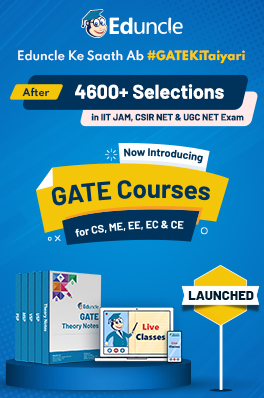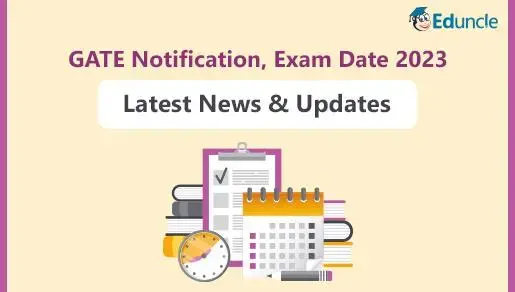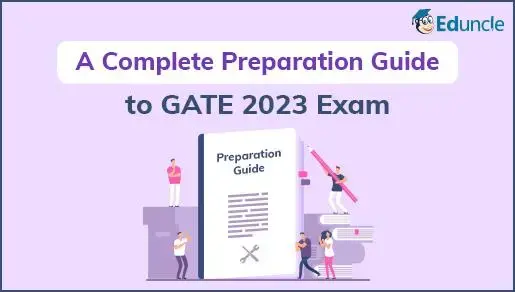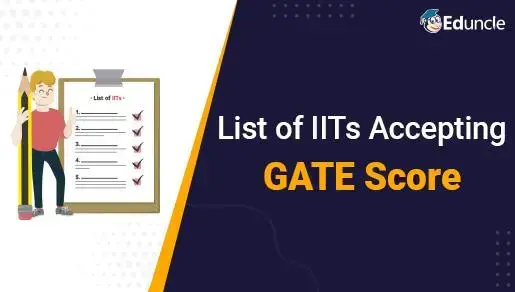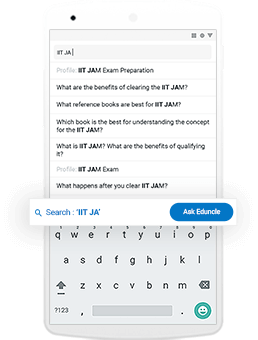Every year, the Graduate Aptitude Test in Engineering exam is conducted by 7 IITs and IISc Bangalore to provide admissions in the Indian Institutes of Technology.
Candidates who are interested in studying in PG Courses like Science, Technology, & Engineering related fields can prepare for this exam.
But before starting your exam preparation, it is important to know the complete GATE Exam syllabus 2023. From 2022, the exam has started conducted in 29 subjects.
At Eduncle, we have provided you the complete GATE 2023 syllabus for all 29 subjects. You can check the syllabus below and cover all the important topics to get good marks in the exam.
2023 GATE Syllabus for CSE, ME, ECE
Important Topics under GATE 2023 Syllabus
GATE Syllabus 2023 PDF – Download for All Subjects
Complete knowledge of the GATE syllabus 2023 helps you to prepare a timetable and to cover all the topics for the exam.
The syllabus of the GATE Exam is divided into 2 parts: -
General Aptitude
Subject Related
Here, we have provided you the official PDF of the GATE Syllabus 2023. You can download the PDF from the given table below: -
| Subjects Name |
Code |
| GA |
|
| AE |
|
| AG |
|
| AR |
|
| BM |
|
| BT |
|
| CE |
|
| CH |
|
| CS |
|
| CY |
|
| EC |
|
| EE |
|
| Environmental Science and Engineering | ES |
| EY |
|
| GE |
|
| GG |
|
| IN |
|
| MA |
|
| ME |
|
| MN |
|
| MT |
|
| NM |
|
| PE |
|
| PH |
|
| PI |
|
| ST |
|
| TF |
|
| XE |
|
| XL |
|
| XH |
Suggested Reads:
Top Engineering Colleges in India
GATE Syllabus for ECE, CSE, and ME
Below, we have mentioned the detailed syllabus of three major subjects CSE ME and ECE.
GATE 2023 Syllabus for Mechanical Engineering (ME)
| Section 1: Engineering Mathematics |
| Linear Algebra: Matrix algebra, systems of linear equations, eigenvalues, and eigenvectors.
Calculus: Functions of a single variable, limit, continuity, and differentiability, mean value theorems, indeterminate forms, evaluation of definite and improper integrals, double and triple integrals, partial derivatives, total derivative, Taylor series (in one and two variables), maxima and minima, Fourier series, gradient, divergence and curl, vector identities, directional derivatives, line, surface and volume integrals, applications of Gauss, Stokes, and Green’s Theorems.
Differential equations: First order equations (linear and nonlinear), higher-order linear differential equations with constant coefficients, Euler-Cauchy equation, initial and boundary value problems, Laplace transforms, solutions of heat, wave, and Laplace's equations. Complex variables: Analytic functions, Cauchy-Riemann equations, Cauchy’s integral theorem, and integral formula, Taylor, and Laurent series.
Probability and Statistics: Definitions of probability, sampling theorems, conditional probability, mean, median, mode and standard deviation, random variables, binomial, Poisson, and Normal Distributions.
Numerical Methods: Numerical solutions of linear and non-linear algebraic equations, integration by trapezoidal and Simpson’s rules, single and multi-step methods for differential equations. |
| Section 2: Applied Mechanics and Design |
| Engineering Mechanics: Free-body diagrams and equilibrium, friction and its applications including rolling friction, belt-pulley, brakes, clutches, screw jack, wedge, vehicles, etc., trusses and frames, virtual work, kinematics, and dynamics of rigid bodies in plane motion, impulse, and momentum (linear and angular) and energy formulations, Lagrange’s equation.
Mechanics of Materials: Stress and strain, elastic constants, Poisson's ratio, Mohr’s circle for plane stress and plane strain, thin cylinders, shear force and bending moment diagrams, bending and shear stresses, the concept of shear centre, deflection of beams, torsion of circular shafts, Euler’s theory of columns, energy methods, thermal stresses, strain gauges and rosettes, testing of materials with the universal testing machine, testing of hardness and impact strength.
Theory of Machines: Displacement, velocity and acceleration analysis of plane mechanisms, dynamic analysis of linkages, cams, gears and gear trains, flywheels, and governors, balancing of reciprocating and rotating masses, gyroscope. Vibrations: Free and forced vibration of single degree of freedom systems, the effect of damping, vibration isolation, resonance, critical speeds of shafts.
Machine Design: Design for static and dynamic loading, failure theories, fatigue strength and S-N diagram, principles of the design of machine elements such as bolted, riveted, and welded joints, shafts, gears, rolling, and sliding contact bearings, brakes, and clutches, springs. |
| Section 3: Fluid Mechanics and Thermal Sciences |
| Fluid Mechanics: Fluid properties, fluid statics, forces on submerged bodies, stability of floating bodies, control-volume analysis of mass, momentum, and energy, fluid acceleration, differential equations of continuity and momentum, Bernoulli’s equation, dimensional analysis, viscous flow of incompressible fluids, boundary layer, elementary turbulent flow, flow through pipes, head losses in pipes, bends, and fittings, basics of compressible fluid flow.
Heat-Transfer: Modes of heat transfer, one-dimensional heat conduction, resistance concept, and electrical analogy, heat transfer through fins, unsteady heat conduction, lumped parameter system, Heisler's charts, thermal boundary layer, dimensionless parameters in free and forced convective heat transfer, heat transfer correlations for flow over flat plates and through pipes, the effect of turbulence, heat exchanger performance, LMTD and NTU methods, radiative heat transfer, Stefan- Boltzmann law, Wien's displacement law, black and grey surfaces, view factors, radiation network analysis.
Thermodynamics: Thermodynamic systems and processes, properties of pure substances, the behavior of ideal and real gases, zeroth and first laws of thermodynamics, calculation of work and heat in various processes, the second law of thermodynamics, thermodynamic property charts and tables, availability and irreversibility, thermodynamic relations.
Applications: Power Engineering: Air and gas compressors, vapour and gas power cycles, concepts of regeneration and reheat. I.C. Engines: Air-standard Otto, Diesel, and dual cycles.
Refrigeration and air-conditioning: Vapour and gas refrigeration and heat pump cycles, properties of moist air, psychrometric chart, basic psychrometric processes.
Turbomachinery: Impulse and reaction principles, velocity diagrams, Pelton-wheel, Francis and Kaplan turbines, steam, and gas turbines. |
| Section 4: Materials, Manufacturing, and Industrial Engineering |
| Engineering Materials: Structure and properties of engineering materials, phase diagrams, heat treatment, stress-strain diagrams for engineering materials.
Casting, Forming, and Joining Processes: Different types of castings, design of patterns, moulds and cores, solidification and cooling, riser, and gating design. Plastic deformation and yield criteria, fundamentals of hot and cold working processes, load estimation for bulk (forging, rolling, extrusion, drawing) and sheet (shearing, deep drawing, bending) metal forming processes, principles of powder metallurgy. Principles of welding, brazing, soldering, and adhesive bonding.
Machining and Machine Tool Operations: Mechanics of machining, basic machine tools, single and multi-point cutting tools, tool geometry and materials, tool life and wear, the economics of machining, principles of non-traditional machining processes, principles of work holding, jigs and fixtures, abrasive machining processes, NC/CNC machines, and CNC programming.
Metrology and Inspection: Limits, fits and tolerances, linear and angular measurements, comparators, interferometry, form and finish measurement, alignment and testing methods, tolerance analysis in manufacturing and assembly, concepts of the coordinate-measuring machine.
Computer Integrated Manufacturing: Basic concepts of CAD/CAM and their integration tools, additive manufacturing.
Production Planning and Control: Forecasting models, aggregate production planning, scheduling, materials requirement planning, lean manufacturing.
Inventory Control: Deterministic models, safety stock inventory control systems.
Operations Research: Linear programming, simplex method, transportation, assignment, network flow models, simple queuing models, PERT, and CPM. |
GATE Syllabus for ECE (Electronics and Communications)
| Section 1: Engineering Mathematics |
| Linear Algebra: Vector space, basis, linear dependence, and independence, matrix algebra, eigenvalues and eigenvectors, rank, solution of linear equations- existence and uniqueness.
Calculus: Mean value theorems, theorems of integral calculus, evaluation of definite and improper integrals, partial derivatives, maxima and minima, multiple integrals, line, surface, and volume integrals, Taylor series.
Differential Equations: First order equations (linear and nonlinear), higher-order linear differential equations, Cauchy's and Euler's equations, methods of solution using a variation of parameters, complementary function, and particular integral, partial differential equations, variable separable method, initial and boundary value problems.
Vector Analysis: Vectors in plane and space, vector operations, gradient, divergence and curl, Gauss's, Green's, and Stokes’ theorems.
Complex Analysis: Analytic functions, Cauchy’s integral theorem, Cauchy’s integral formula, sequences, series, convergence tests, Taylor and Laurent series, residue theorem.
Probability and Statistics: Mean, median, mode, standard deviation, combinatorial probability, probability distributions, binomial distribution, Poisson distribution, exponential distribution, normal distribution, joint and conditional probability.
|
| Section 2: Networks, Signals, and Systems |
| Circuit analysis: Node and mesh analysis, superposition, Thevenin's theorem, Norton’s theorem, reciprocity. Sinusoidal steady-state analysis: phasors, complex power, maximum power transfer. Time and frequency domain analysis of linear circuits: RL, RC and RLC circuits, Solution of network equations using Laplace transform, Linear 2-port network parameters, wye-delta transformation.
Continuous-time signals: Fourier series and Fourier transform, sampling theorem and applications.
Discrete-time signals: DTFT, DFT, z-transform, discrete-time processing of continuous-time signals. LTI systems: definition and properties, causality, stability, impulse response, convolution, poles and zeroes, frequency response, group delay, phase delay. |
| Section 3: Electronic Devices |
| Energy bands in intrinsic and extrinsic semiconductors, equilibrium carrier concentration, direct and indirect band-gap semiconductors.
Carrier transport: diffusion current, drift current, mobility and resistivity, generation and recombination of carriers, Poisson, and continuity equations, P-N junction, Zener diode, BJT, MOS capacitor, MOSFET, LED, photodiode, and solar cell. |
| Section 4: Analog Circuits |
| Diode circuits: clipping, clamping, and rectifiers.
BJT and MOSFET amplifiers: biasing, ac coupling, small-signal analysis, frequency response. Current mirrors and differential amplifiers.
Op-amp circuits: Amplifiers, summers, differentiators, integrators, active filters, Schmitt triggers, and oscillators. |
| Section 5: Digital Circuits |
| Number representations: binary, integer, and floating-point- numbers.
Combinatorial circuits: Boolean algebra, minimization of functions using Boolean identities and Karnaugh map, logic gates, and their static CMOS implementations, arithmetic circuits, code converters, multiplexers, decoders.
Sequential circuits: latches and flip-flops, counters, shift-registers, finite state machines, propagation delay, setup and hold time, critical path delay.
Data converters: sample and hold circuits, ADCs, and DACs. Semiconductor memories: ROM, SRAM, DRAM.
Computer organization: Machine instructions and addressing modes, ALU, data-path, and control unit, instruction pipelining. |
| Section 6: Control Systems |
| Basic control system components, Feedback principle, Transfer function, Block diagram representation, Signal flow graph, Transient and steady-state analysis of LTI systems, Frequency response, Routh-Hurwitz, and Nyquist stability criteria, Bode and root-locus plots, Lag, lead and lag-lead compensation, State variable model and solution of state equation of LTI systems. |
| Section 7: Communications |
| Random processes: autocorrelation and power spectral density, properties of white noise, filtering of random signals through LTI systems.
Analog communications: amplitude modulation and demodulation, angle modulation and demodulation, spectra of AM and FM, superheterodyne receivers.
Information theory: entropy, mutual information, and channel capacity theorem.
Digital communications: PCM, DPCM, digital modulation schemes (ASK, PSK, FSK, QAM), bandwidth, inter-symbol interference, MAP, ML detection, matched filter receiver, SNR, and BER. Fundamentals of error correction, Hamming codes, CRC. |
| Section 8: Electromagnetics |
| Maxwell's equations: differential and integral forms and their interpretation, boundary conditions, wave equation, Poynting vector.
Plane waves and properties: reflection and refraction, polarization, phase and group velocity, propagation through various media, skin depth.
Transmission lines: equations, characteristic impedance, impedance matching, impedance transformation, S-parameters, Smith chart. Rectangular and circular waveguides, light propagation in optical fibers, dipole and monopole antennas, linear antenna arrays. |
GATE Syllabus for CSE (Computer Science and Information Technology)
| Section 1: Engineering Mathematics |
| Discrete Mathematics: Propositional and first-order logic. Sets, relations, functions, partial orders, and lattices. Monoids, Groups. Graphs: connectivity, matching, coloring. Combinatorics, counting, recurrence relations, generating functions.
Linear Algebra: Matrices, determinants, the system of linear equations, eigenvalues and eigenvectors, LU decomposition.
Calculus: Limits, continuity, and differentiability. Maxima and minima. Mean value theorem, and Integration.
Probability and Statistics: Random variables. Uniform, normal, exponential, Poisson, and binomial distributions. Mean, median, mode, and standard deviation. Conditional probability and Bayes theorem. |
| Section 2: Digital Logic |
| Boolean algebra, Combinational and sequential circuits, Minimization, Number representations, and computer arithmetic (fixed and floating-point). |
| Section 3: Computer Organization and Architecture |
| Machine instructions and addressing modes. ALU, data-path, and control unit. Instruction pipelining, pipeline hazards. Memory hierarchy: cache, main memory, and secondary storage, I/O interface (interrupt and DMA mode). |
| Section 4: Programming and Data Structures |
| Programming in C. Recursion. Arrays, stacks, queues, linked lists, trees, binary search trees, binary heaps, graphs. |
| Section 5: Algorithms |
| Searching, sorting, hashing. Asymptotic worst-case time and space complexity. Algorithm design techniques: greedy, dynamic programming, and divide-and-conquer. Graph traversals, minimum spanning trees, shortest paths |
| Section 6: Theory of Computation |
| Regular expressions and finite automata. Context-free grammars and push-down automata. Regular and context-free languages, pumping lemma. Turing machines and undecidability. |
| Section 7: Compiler Design |
| Lexical analysis, parsing, syntax-directed translation. Runtime environments. Intermediate code generation. Local optimization, Data flow analyses: constant propagation, liveness analysis, common subexpression elimination. |
| Section 8: Operating System |
| System calls, processes, threads, inter-process communication, concurrency, and synchronization. Deadlock. CPU and I/O scheduling. Memory management and virtual memory. File systems. |
| Section 9: Databases |
| ER-model. Relational model: relational algebra, tuple calculus, SQL. Integrity constraints, normal forms. File organization, indexing (e.g., B and B+ trees). Transactions and concurrency control. |
| Section 10: Computer Networks |
| Concept of layering: OSI and TCP/IP Protocol Stacks; Basics of the packet, circuit, and virtual circuit switching; Data link layer: framing, error detection, Medium Access Control, Ethernet bridging; Routing protocols: shortest path, flooding, distance vector, and link-state routing; Fragmentation and IP addressing, IPv4, CIDR notation, Basics of IP support protocols (ARP, DHCP, ICMP), Network Address Translation (NAT); Transport layer: flow control and congestion control, UDP, TCP, sockets; Application layer protocols: DNS, SMTP, HTTP, FTP, Email. |
Important Topics of Graduate Aptitude Test 2023
Your preparation will become easy if you have an idea of the important topics that have high weightage in the exam.
Here, you can check the list of important topics of the GATE 2023 Exam of all major subjects below: -
| Subject |
Important Topics |
| General Aptitude |
Verbal Ability: Spelling, Synonyms & Antonyms, Verbal Deductions, Sentence Completion. Numerical Ability: Number Series, Data Interpretation, Ages, Directions Probability, Clock Problems, Speed, Distance & Time, Logical Inference. |
| Civil Engineering
|
Deflection of Beams, Moment Distribution Method, Kinematics and Static Indeterminacy, SFD and BMD Soil Index Properties, Effect of Water, Table on Soil, Seepage Analysis, Hydrographs, Turbulent Flow, Water Requirement for Crops, Noise Pollution Sedimentation Tank. |
| Computer Science and Information Technology (CSE)
|
Cache Organization, Addressing Modes Stacks, Trees, Analysis, Graph Algorithms, Regular Expressions Closure Properties, Predictive Parser LR Parsers, Virtual Memory. |
| Electronics and Communication Engineering
|
Network Theorems, Two-port Networks LTI Systems, Fourier Transform Laplace Transform, Basics of Signals and Systems, Signal Flow Graphs Routh-Hurwitz Criteria, Combinational Circuits, Sequential Circuits. |
| Electrical Engineering
|
DC machines, three-phase transformers, Servo motors, and Stepper Motors, Circuit Breakers, Power system Protection, HVDC and FACTS concepts, Time Domain Analysis, Nyquist and Bode Plots, Logic Gates, Boolean Algebra & K-Map, 8085 Microprocessor. |
| Mechanical Engineering
|
Orthogonal Cutting, Casting Types and Design, Laws of TD, Flow-through Pipes Velocity Potential, Boundary Layer Theory, Linkages, Inversions of Single and Double Slider Crank, Queuing Theory, Inventory Control. |
GATE Syllabus 2023 Frequently Asked Queries
We have come up with a list of questions frequently asked by aspirants regarding the GATE syllabus 2023. If you have any queries regarding the same, then you should check the following FAQs:
Question: Will there be any changes in GATE Syllabus 2023?
Ans.) As per the latest update, there is no changes in GATE 2023 Syllabus, so we can say that the 2023 syllabus will be the same as 2022. If any changes will be made further by the officials, we will update you in the same blog.. You can check all the latest notifications of the Graduate Aptitude Test here.
Question: What are the important topics under the GATE Exam Syllabus 2023?
Ans.) To know the important topics of the 2023 exam, you can click here.
Question: What are the types of questions asked in the Graduate Aptitude Test?
Ans.) According to the GATE Exam Pattern, there will be three types of questions –
Multiple Choice Questions (MCQ)
Multiple Select Questions (MSQ)
Numerical Answer Type Questions (NAT)
Question: Is the GATE 2023 syllabus of general aptitude common for all papers?
Ans.) The General Aptitude syllabus is common for all subjects. If you are appearing for the exam, then download the complete GATE syllabus 2023 PDF here.
Question-How many subjects are there in the GATE Exam syllabus 2023?
Ans.) GATE 2023 syllabus comprises 29 subjects including:
General Aptitude
Computer Science and Information Technology
Electrical Engineering
Engineering Mathematics
Environmental Science and Engineering
Reasoning and Comprehension
Question: For how many papers can a student appear in GATE?
Ans.) Candidates can appear only in one subject or paper on the Graduate Aptitude Test.
After checking the complete syllabus, it is also important to know about the GATE Exam 2023 Pattern so that you can make a proper strategy for the exam.
We hope now you can prepare well for the exam with the help of the GATE Exam syllabus and a list of all the important topics.
If you have any queries regarding the same, you can ask us in the comment section below. We'll be happy to assist you.
Thank You!









